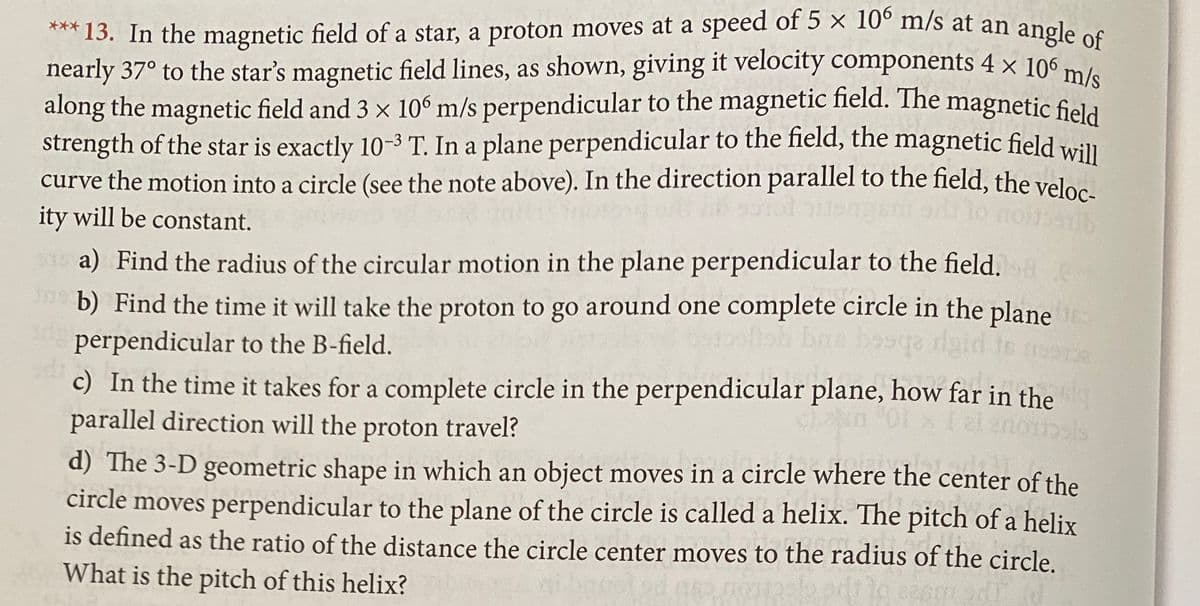*** 13. In the magnetic field of a star, a proton moves at a speed of 5 x 10° m/s at an angle of nearly 37° to the star's magnetic field lines, as shown, giving it velocity components 4 × 106 m/e along the magnetic field and 3 x 10° m/s perpendicular to the magnetic field. The magnetic fiela strength of the star is exactly 10-3 T. In a plane perpendicular to the field, the magnetic field will curve the motion into a circle (see the note above). In the direction parallel to the field, the veloc ity will be constant. a) Find the radius of the circular motion in the plane perpendicular to the field. b) Find the time it will take the proton to go around one complete circle in the plane perpendicular to the B-field. c) In the time it takes for a complete circle in the perpendicular plane, how far in the parallel direction will the proton travel? d) The 3-D geometric shape in which an object moves in a circle where the center of the circle moves perpendicular to the plane of the circle is called a helix. The pitch of a helix is defined as the ratio of the distance the circle center moves to the radius of the circle. What is the pitch of this helix?
*** 13. In the magnetic field of a star, a proton moves at a speed of 5 x 10° m/s at an angle of nearly 37° to the star's magnetic field lines, as shown, giving it velocity components 4 × 106 m/e along the magnetic field and 3 x 10° m/s perpendicular to the magnetic field. The magnetic fiela strength of the star is exactly 10-3 T. In a plane perpendicular to the field, the magnetic field will curve the motion into a circle (see the note above). In the direction parallel to the field, the veloc ity will be constant. a) Find the radius of the circular motion in the plane perpendicular to the field. b) Find the time it will take the proton to go around one complete circle in the plane perpendicular to the B-field. c) In the time it takes for a complete circle in the perpendicular plane, how far in the parallel direction will the proton travel? d) The 3-D geometric shape in which an object moves in a circle where the center of the circle moves perpendicular to the plane of the circle is called a helix. The pitch of a helix is defined as the ratio of the distance the circle center moves to the radius of the circle. What is the pitch of this helix?
Physics for Scientists and Engineers, Technology Update (No access codes included)
9th Edition
ISBN:9781305116399
Author:Raymond A. Serway, John W. Jewett
Publisher:Raymond A. Serway, John W. Jewett
Chapter29: Magnetic Fields
Section: Chapter Questions
Problem 29.10OQ: A charged particle is traveling through a uniform magnetic field. Which of the following statements...
Related questions
Question
100%

Transcribed Image Text:*** 13. In the magnetic field of a star, a proton moves at a speed of 5 x 10° m/s at an angle es
nearly 37° to the star's magnetic field lines, as shown, giving it velocity components 4 × 106 m
along the magnetic field and 3 x 10° m/s perpendicular to the magnetic field. The magnetic fiela
strength of the star is exactly 10-3 T. In a plane perpendicular to the field, the magnetic field will
curve the motion into a circle (see the note above). In the direction parallel to the field, the veloa
ity will be constant.
a) Find the radius of the circular motion in the plane perpendicular to the field. 8
b) Find the time it will take the proton to go around one complete circle in the plane
perpendicular to the B-field.
bre bosqa igid
c) In the time it takes for a complete circle in the perpendicular plane, how far in the
parallel direction will the proton travel?
d) The 3-D geometric shape in which an object moves in a circle where the center of the
circle moves perpendicular to the plane of the circle is called a helix. The pitch of a helix
is defined as the ratio of the distance the circle center moves to the radius of the circle.
What is the pitch of this helix?
Expert Solution
This question has been solved!
Explore an expertly crafted, step-by-step solution for a thorough understanding of key concepts.
Step by step
Solved in 2 steps with 1 images

Knowledge Booster
Learn more about
Need a deep-dive on the concept behind this application? Look no further. Learn more about this topic, physics and related others by exploring similar questions and additional content below.Recommended textbooks for you

Physics for Scientists and Engineers, Technology …
Physics
ISBN:
9781305116399
Author:
Raymond A. Serway, John W. Jewett
Publisher:
Cengage Learning

Physics for Scientists and Engineers with Modern …
Physics
ISBN:
9781337553292
Author:
Raymond A. Serway, John W. Jewett
Publisher:
Cengage Learning

Physics for Scientists and Engineers
Physics
ISBN:
9781337553278
Author:
Raymond A. Serway, John W. Jewett
Publisher:
Cengage Learning

Physics for Scientists and Engineers, Technology …
Physics
ISBN:
9781305116399
Author:
Raymond A. Serway, John W. Jewett
Publisher:
Cengage Learning

Physics for Scientists and Engineers with Modern …
Physics
ISBN:
9781337553292
Author:
Raymond A. Serway, John W. Jewett
Publisher:
Cengage Learning

Physics for Scientists and Engineers
Physics
ISBN:
9781337553278
Author:
Raymond A. Serway, John W. Jewett
Publisher:
Cengage Learning

Principles of Physics: A Calculus-Based Text
Physics
ISBN:
9781133104261
Author:
Raymond A. Serway, John W. Jewett
Publisher:
Cengage Learning

College Physics
Physics
ISBN:
9781285737027
Author:
Raymond A. Serway, Chris Vuille
Publisher:
Cengage Learning

College Physics
Physics
ISBN:
9781305952300
Author:
Raymond A. Serway, Chris Vuille
Publisher:
Cengage Learning